GMC SONOMA 2003 Workshop Manual
Manufacturer: GMC, Model Year: 2003, Model line: SONOMA, Model: GMC SONOMA 2003Pages: 424, PDF Size: 2.45 MB
Page 51 of 424
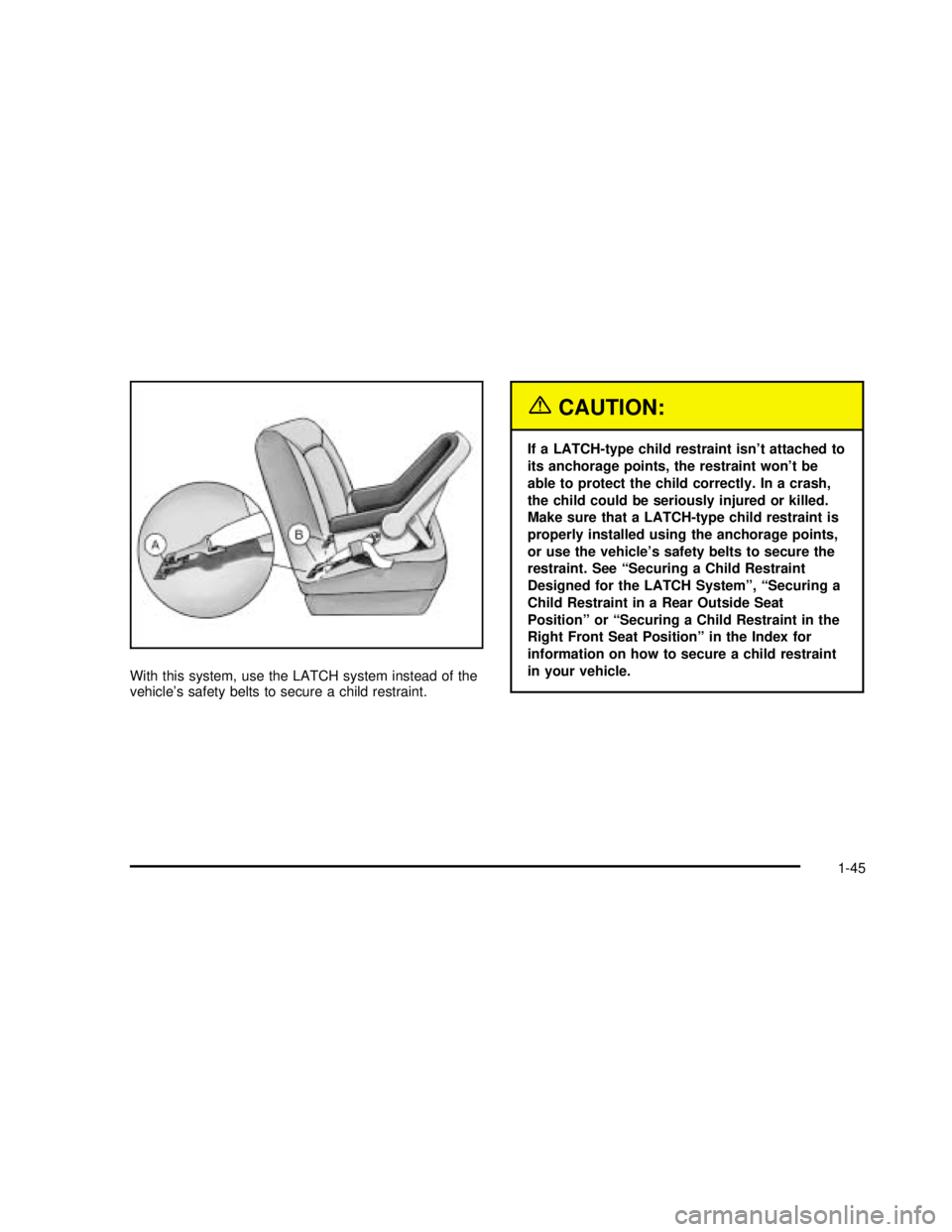
With this system, use the LATCH system instead of the
vehicle’s safety belts to secure a child restraint.
{CAUTION:
If a LATCH-type child restraint isn’t attached to
its anchorage points, the restraint won’t be
able to protect the child correctly. In a crash,
the child could be seriously injured or killed.
Make sure that a LATCH-type child restraint is
properly installed using the anchorage points,
or use the vehicle’s safety belts to secure the
restraint. See “Securing a Child Restraint
Designed for the LATCH System”, “Securing a
Child Restraint in a Rear Outside Seat
Position” or “Securing a Child Restraint in the
Right Front Seat Position” in the Index for
information on howto secure a child restraint
in your vehicle.
1-45
2003 - Sonoma OM
Page 52 of 424
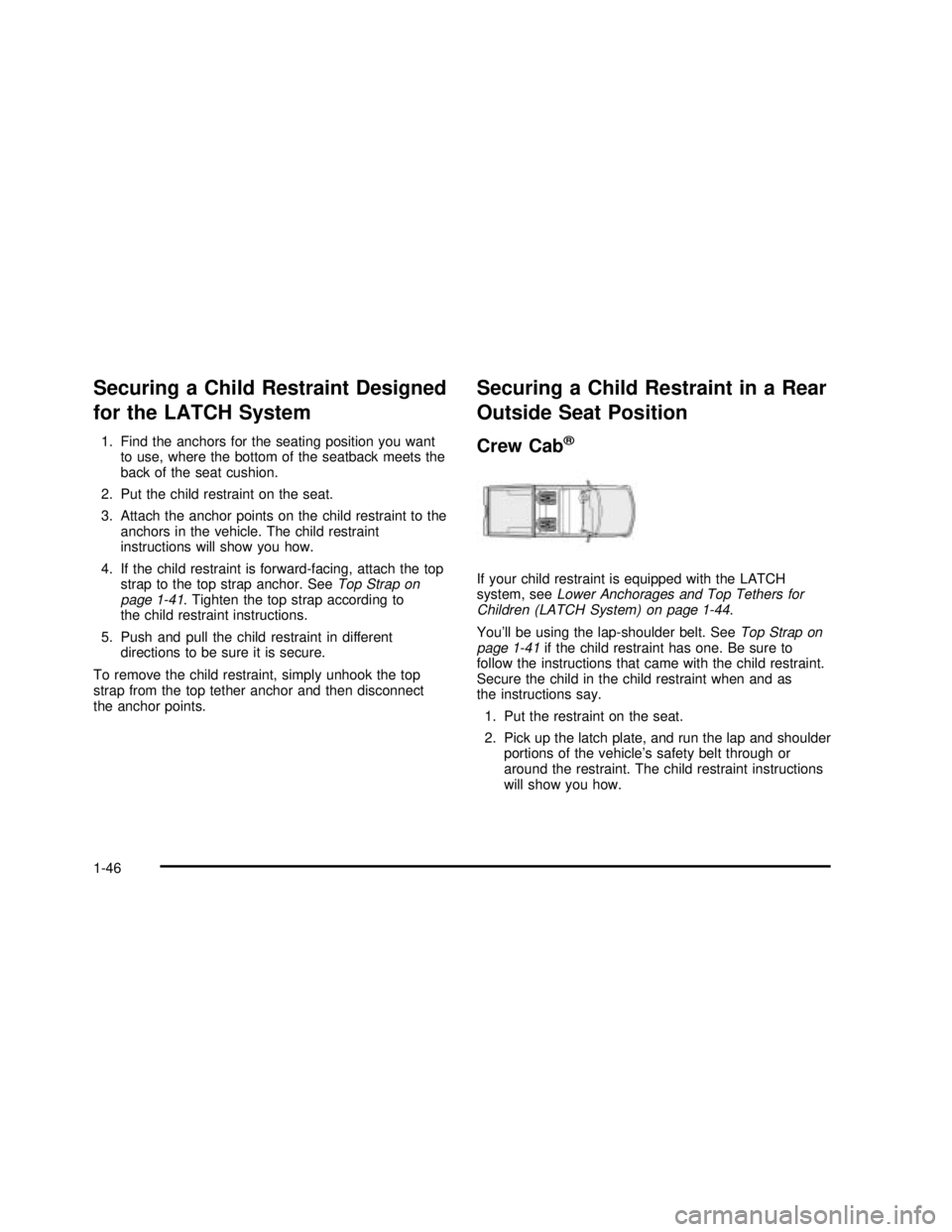
Securing a Child Restraint Designed
for the LATCH System
1. Find the anchors for the seating position you want
to use, where the bottom of the seatback meets the
back of the seat cushion.
2. Put the child restraint on the seat.
3. Attach the anchor points on the child restraint to the
anchors in the vehicle. The child restraint
instructions will show you how.
4. If the child restraint is forward-facing, attach the top
strap to the top strap anchor. SeeTop Strap on
page 1-41. Tighten the top strap according to
the child restraint instructions.
5. Push and pull the child restraint in different
directions to be sure it is secure.
To remove the child restraint, simply unhook the top
strap from the top tether anchor and then disconnect
the anchor points.
Securing a Child Restraint in a Rear
Outside Seat Position
CrewCab®
If your child restraint is equipped with the LATCH
system, seeLower Anchorages and Top Tethers for
Children (LATCH System) on page 1-44.
You’ll be using the lap-shoulder belt. SeeTop Strap on
page 1-41if the child restraint has one. Be sure to
follow the instructions that came with the child restraint.
Secure the child in the child restraint when and as
the instructions say.
1. Put the restraint on the seat.
2. Pick up the latch plate, and run the lap and shoulder
portions of the vehicle’s safety belt through or
around the restraint. The child restraint instructions
will show you how.
1-46
2003 - Sonoma OM
Page 53 of 424
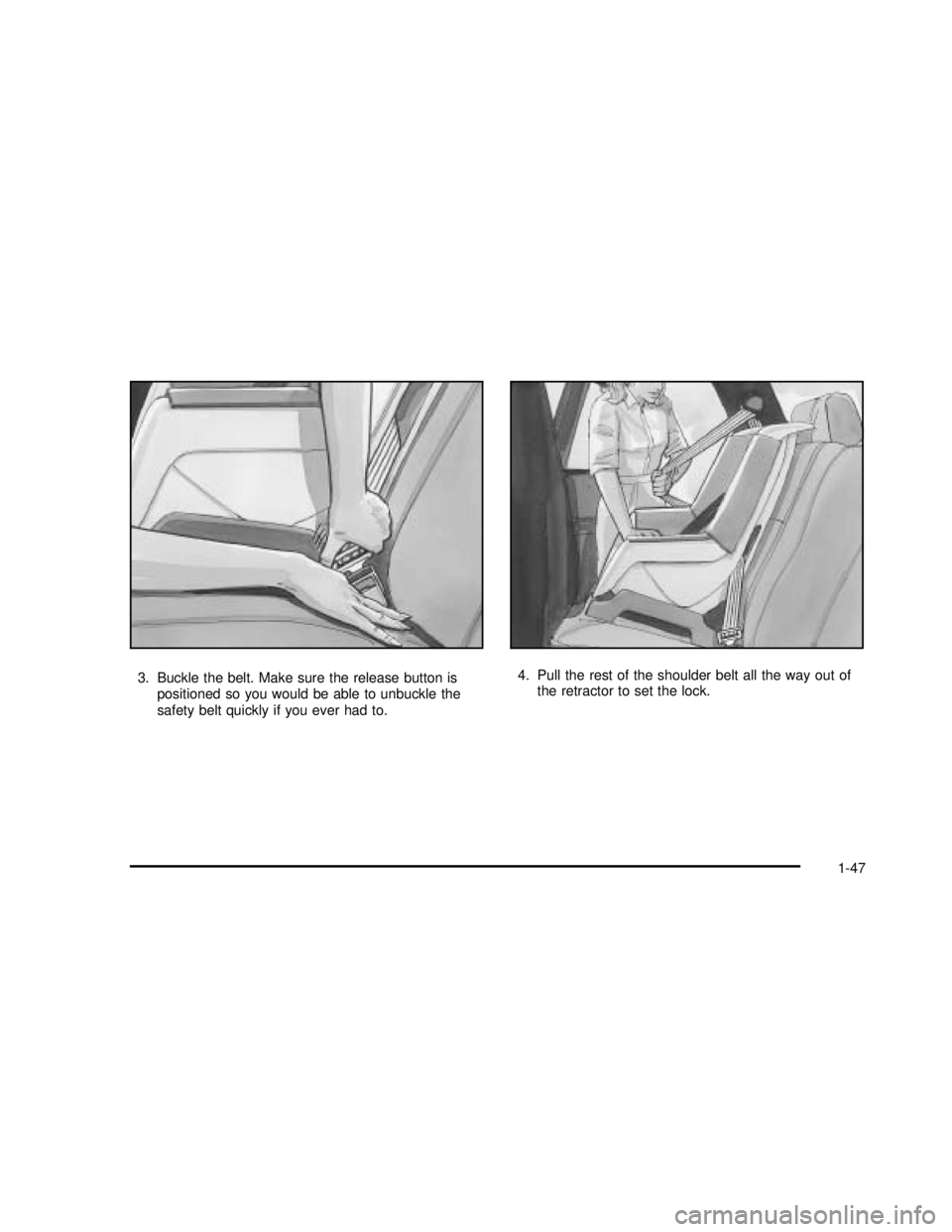
3. Buckle the belt. Make sure the release button is
positioned so you would be able to unbuckle the
safety belt quickly if you ever had to.4. Pull the rest of the shoulder belt all the way out of
the retractor to set the lock.
1-47
2003 - Sonoma OM
Page 54 of 424
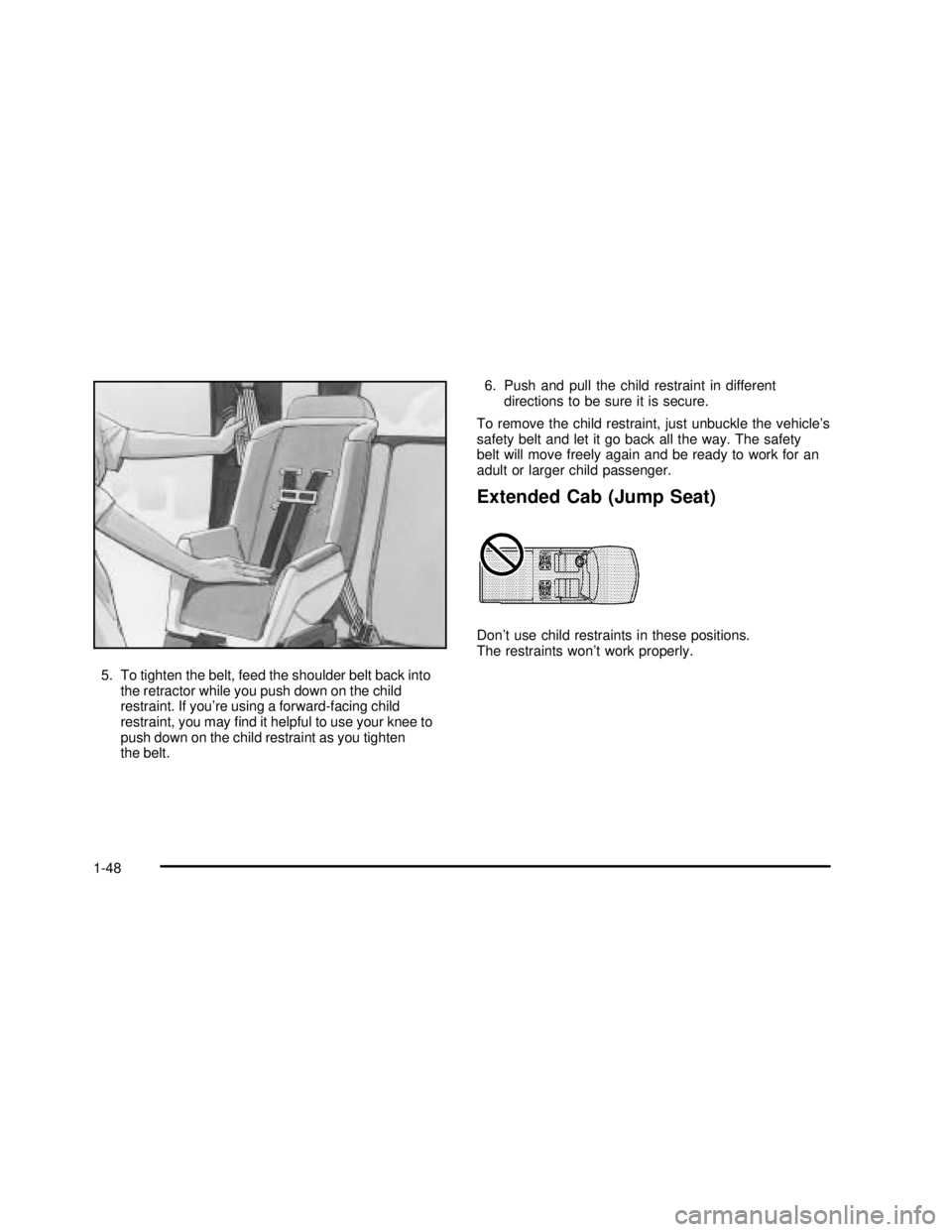
5. To tighten the belt, feed the shoulder belt back into
the retractor while you push down on the child
restraint. If you’re using a forward-facing child
restraint, you mayfind it helpful to use your knee to
push down on the child restraint as you tighten
the belt.6. Push and pull the child restraint in different
directions to be sure it is secure.
To remove the child restraint, just unbuckle the vehicle’s
safety belt and let it go back all the way. The safety
belt will move freely again and be ready to work for an
adult or larger child passenger.
Extended Cab (Jump Seat)
Don’t use child restraints in these positions.
The restraints won’t work properly.
1-48
2003 - Sonoma OM
Page 55 of 424
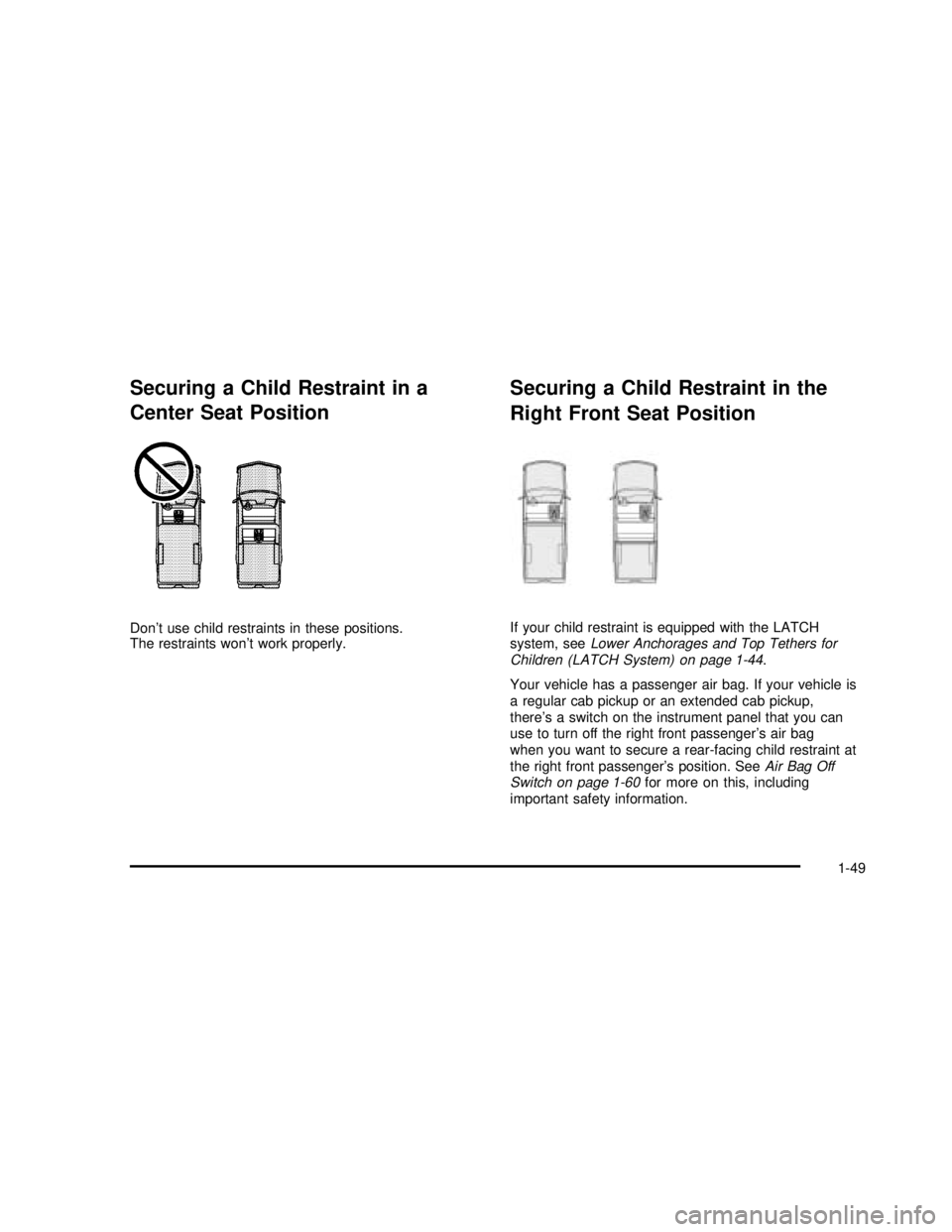
Securing a Child Restraint in a
Center Seat Position
Don’t use child restraints in these positions.
The restraints won’t work properly.
Securing a Child Restraint in the
Right Front Seat Position
If your child restraint is equipped with the LATCH
system, seeLower Anchorages and Top Tethers for
Children (LATCH System) on page 1-44.
Your vehicle has a passenger air bag. If your vehicle is
a regular cab pickup or an extended cab pickup,
there’s a switch on the instrument panel that you can
use to turn off the right front passenger’s air bag
when you want to secure a rear-facing child restraint at
the right front passenger’s position. SeeAir Bag Off
Switch on page 1-60for more on this, including
important safety information.
1-49
2003 - Sonoma OM
Page 56 of 424
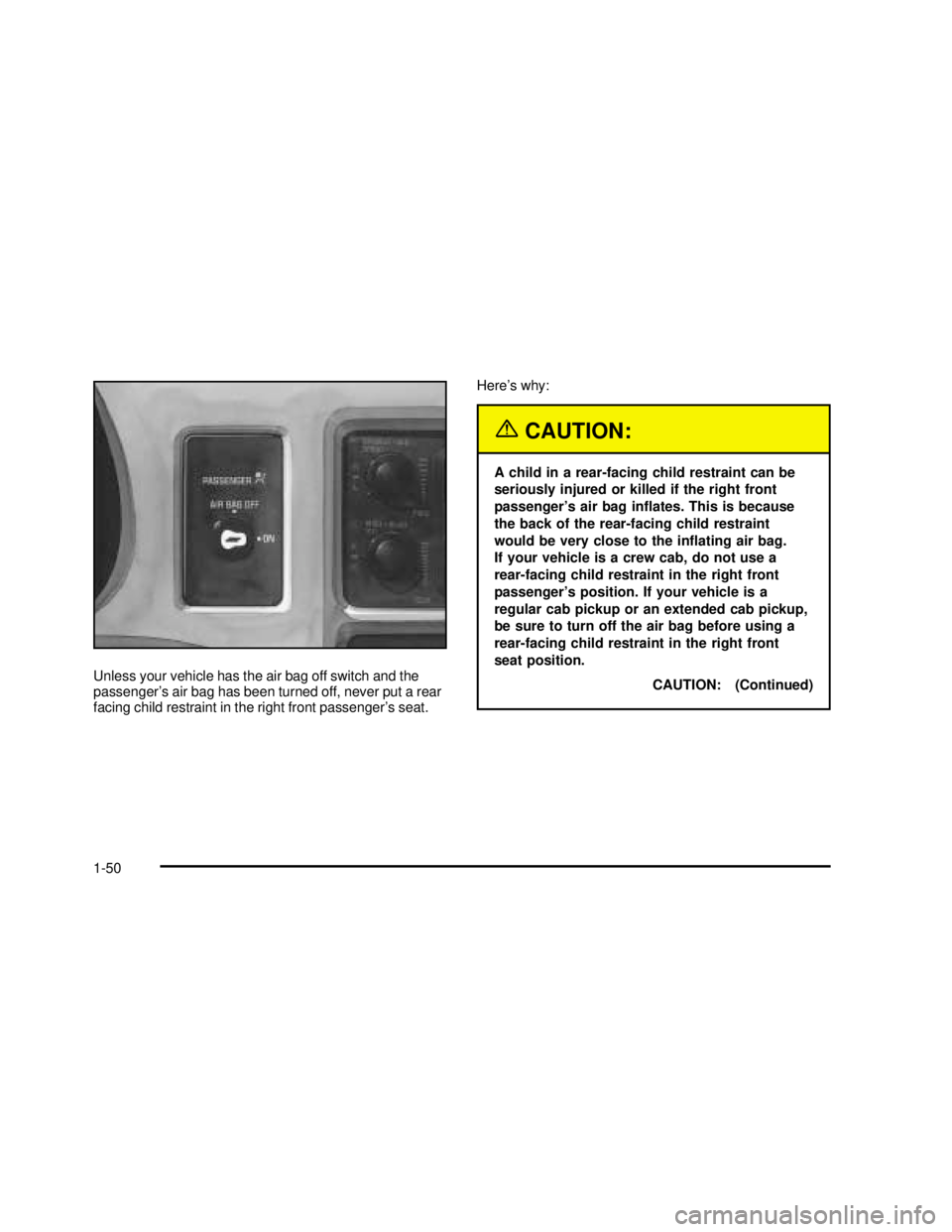
Unless your vehicle has the air bag off switch and the
passenger’s air bag has been turned off, never put a rear
facing child restraint in the right front passenger’s seat.Here’s why:
{CAUTION:
A child in a rear-facing child restraint can be
seriously injured or killed if the right front
passenger’s air bag inflates. This is because
the back of the rear-facing child restraint
would be very close to the inflating air bag.
If your vehicle is a crewcab, do not use a
rear-facing child restraint in the right front
passenger’s position. If your vehicle is a
regular cab pickup or an extended cab pickup,
be sure to turn off the air bag before using a
rear-facing child restraint in the right front
seat position.
CAUTION: (Continued)
1-50
2003 - Sonoma OM
Page 57 of 424
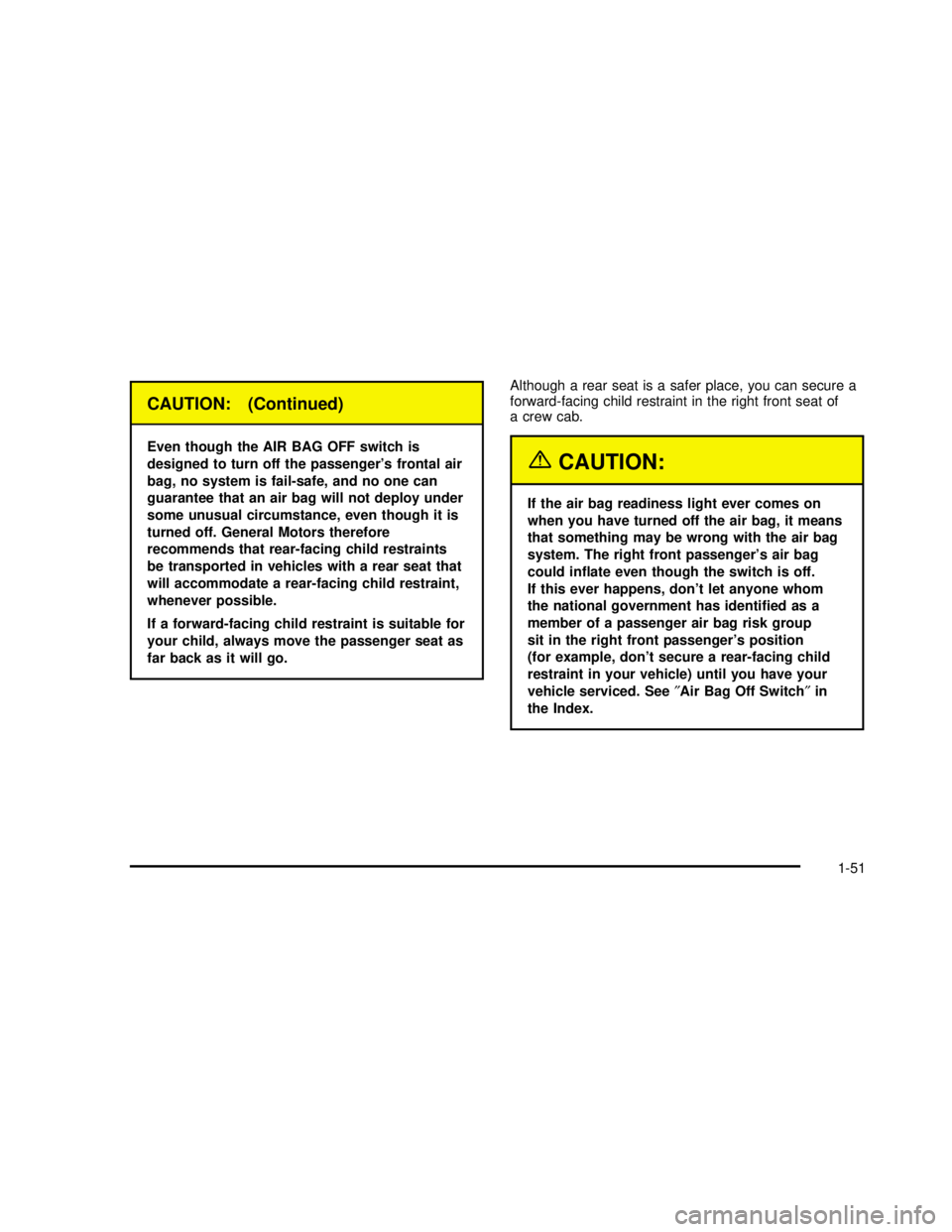
CAUTION: (Continued)
Even though the AIR BAG OFF switch is
designed to turn off the passenger’s frontal air
bag, no system is fail-safe, and no one can
guarantee that an air bag will not deploy under
some unusual circumstance, even though it is
turned off. General Motors therefore
recommends that rear-facing child restraints
be transported in vehicles with a rear seat that
will accommodate a rear-facing child restraint,
whenever possible.
If a forward-facing child restraint is suitable for
your child, always move the passenger seat as
far back as it will go.Although a rear seat is a safer place, you can secure a
forward-facing child restraint in the right front seat of
a crew cab.
{CAUTION:
If the air bag readiness light ever comes on
when you have turned off the air bag, it means
that something may be wrong with the air bag
system. The right front passenger’s air bag
could inflate even though the switch is off.
If this ever happens, don’t let anyone whom
the national government has identified as a
member of a passenger air bag risk group
sit in the right front passenger’s position
(for example, don’t secure a rear-facing child
restraint in your vehicle) until you have your
vehicle serviced. See″Air Bag Off Switch″in
the Index.
1-51
2003 - Sonoma OM
Page 58 of 424
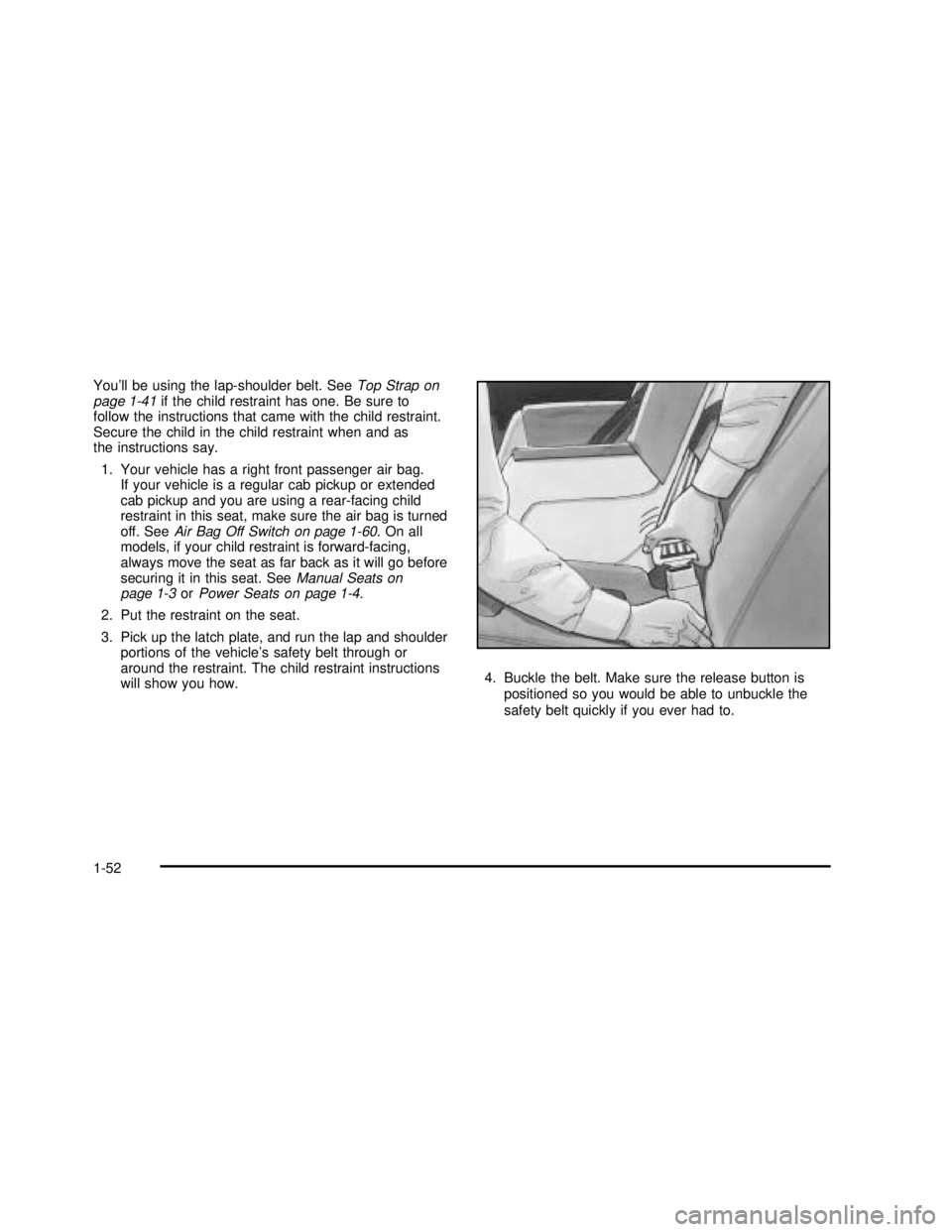
You’ll be using the lap-shoulder belt. SeeTop Strap on
page 1-41if the child restraint has one. Be sure to
follow the instructions that came with the child restraint.
Secure the child in the child restraint when and as
the instructions say.
1. Your vehicle has a right front passenger air bag.
If your vehicle is a regular cab pickup or extended
cab pickup and you are using a rear-facing child
restraint in this seat, make sure the air bag is turned
off. SeeAir Bag Off Switch on page 1-60.Onall
models, if your child restraint is forward-facing,
always move the seat as far back as it will go before
securing it in this seat. SeeManual Seats on
page 1-3orPower Seats on page 1-4.
2. Put the restraint on the seat.
3. Pick up the latch plate, and run the lap and shoulder
portions of the vehicle’s safety belt through or
around the restraint. The child restraint instructions
will show you how.4. Buckle the belt. Make sure the release button is
positioned so you would be able to unbuckle the
safety belt quickly if you ever had to.
1-52
2003 - Sonoma OM
Page 59 of 424
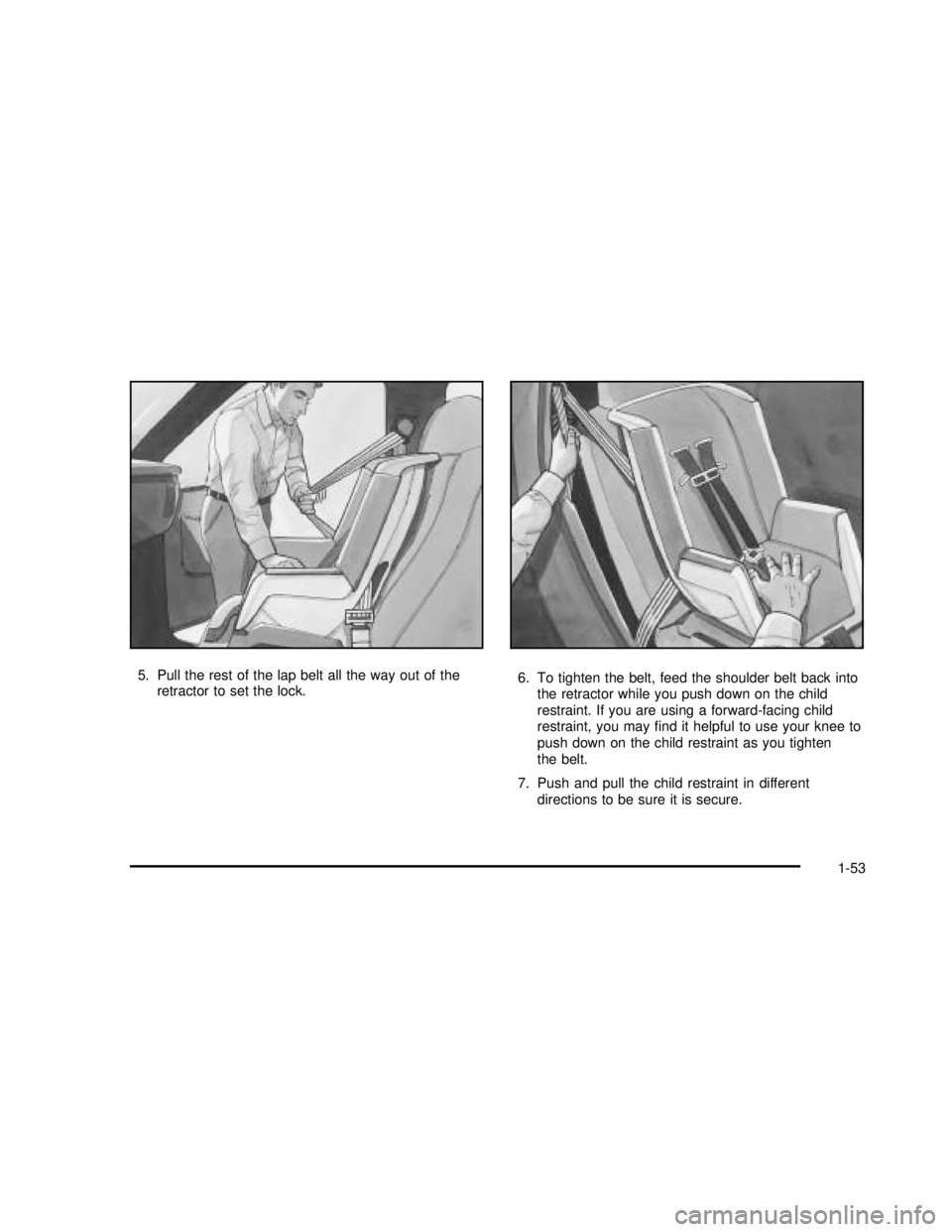
5. Pull the rest of the lap belt all the way out of the
retractor to set the lock.6. To tighten the belt, feed the shoulder belt back into
the retractor while you push down on the child
restraint. If you are using a forward-facing child
restraint, you mayfind it helpful to use your knee to
push down on the child restraint as you tighten
the belt.
7. Push and pull the child restraint in different
directions to be sure it is secure.
1-53
2003 - Sonoma OM
Page 60 of 424
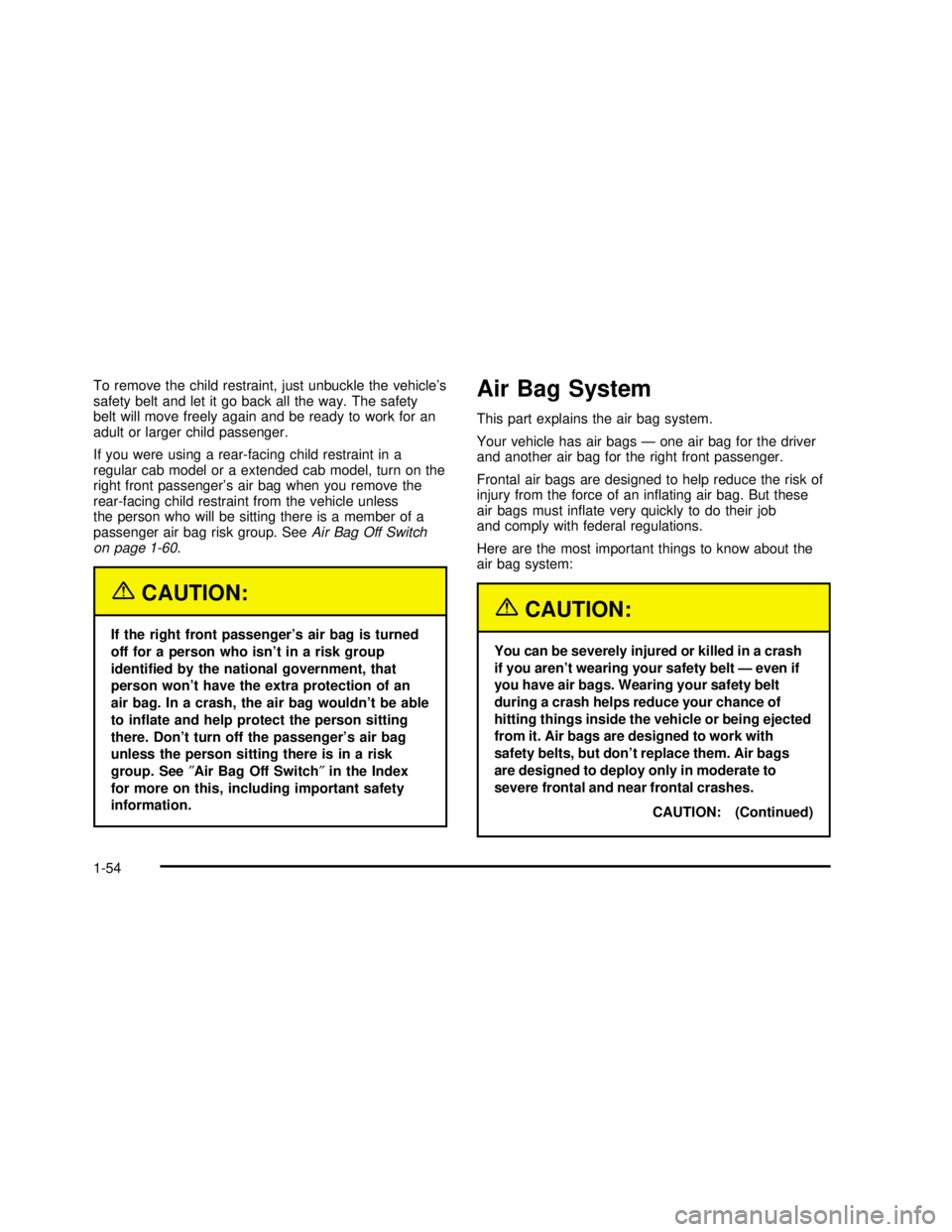
To remove the child restraint, just unbuckle the vehicle’s
safety belt and let it go back all the way. The safety
belt will move freely again and be ready to work for an
adult or larger child passenger.
If you were using a rear-facing child restraint in a
regular cab model or a extended cab model, turn on the
right front passenger’s air bag when you remove the
rear-facing child restraint from the vehicle unless
the person who will be sitting there is a member of a
passenger air bag risk group. SeeAir Bag Off Switch
on page 1-60.
{CAUTION:
If the right front passenger’s air bag is turned
off for a person who isn’t in a risk group
identified by the national government, that
person won’t have the extra protection of an
air bag. In a crash, the air bag wouldn’t be able
to inflate and help protect the person sitting
there. Don’t turn off the passenger’s air bag
unless the person sitting there is in a risk
group. See″Air Bag Off Switch″in the Index
for more on this, including important safety
information.
Air Bag System
This part explains the air bag system.
Your vehicle has air bags—one air bag for the driver
and another air bag for the right front passenger.
Frontal air bags are designed to help reduce the risk of
injury from the force of an inflating air bag. But these
air bags must inflate very quickly to do their job
and comply with federal regulations.
Here are the most important things to know about the
air bag system:
{CAUTION:
You can be severely injured or killed in a crash
if you aren’t wearing your safety belt — even if
you have air bags. Wearing your safety belt
during a crash helps reduce your chance of
hitting things inside the vehicle or being ejected
from it. Air bags are designed to work with
safety belts, but don’t replace them. Air bags
are designed to deploy only in moderate to
severe frontal and near frontal crashes.
CAUTION: (Continued)
1-54
2003 - Sonoma OM